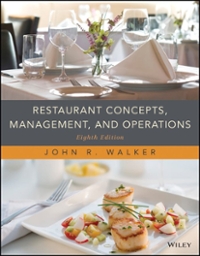Question
JL.51 Carl's Custom Cans produces small containers which are purchased by candy and snack food producers. The production facility operates 350days per year and has
JL.51 Carl's Custom Cans produces small containers which are purchased by candy and snack food producers. The production facility operates 350days per year and has annual demand of 13,200 units for one of its custom cans. They can produce up to 180 of these cans each day. It costs $34.56to set up one of their production lines to run this can. (Carl pays $18per hour for setup labor.) The cost of each can is $1.70and annual holding costs are $.50 per can. What is the optimal size of the production run for this can? (Display your answer to the nearest whole number). Given your answer to the previous question, how many production runs will be required each year in order to meet the annual demand? (Round your answer UP to the nextwhole number.) Suppose the customer for this custom can wants to purchase in quantities of 300 units. What is the required setup cost to make this order quantity an optimal production run quantity for Carl's Custom Cans? (Display your answer to two decimal places.) Based on your answer to the previous question (reduced setup cost), how long (in minutes) should it take to set up this production line? (Display your answer to the nearest whole number.)
JL.53 Bob's Bumpers hasa repetitive manufacturing facility in Kentucky that makes automobile bumpers and other auto body parts. The facility operates 330days per year and has annual demand of 64,000 bumpers. They can produce up to 410 bumpers each day. It costs $57to set up the production line to produce bumpers. The cost of each bumper is $137and annual holding costs are $40 per unit. Setup labor cost is$28per hour. What is the optimal size of the production run for bumpers? (Display your answer to the nearest whole number.) Based on your answer to the previous question, and assuming the manufacturer holds no safety stock, what would be the average inventory for these bumpers? (Display your answer to the nearest whole number.) Based on your answer two questions back, how many production runs will be required each year to satisfy demand? HINT: As a general rule, whenever calculating a value that is based on previous calculations in Excel, always be sure to use cell references rather than a rounded value as a calculationinput. (Display your answer to the appropriatewhole number.) Suppose the customer (an auto manufacturer) wants to purchase in lots of 390 and that Bob's Bumpers is able to reduce setup costs to the point where 390 is now the optimal production run quantity. How much will they save in annual holding costs with this new lower production quantity? (Display your answer to two decimal places.)
How much will they save in annual setupcosts with this new lower production quantity?(Display your answer to two decimal places.)
JL.61 A producer of refrigerator compressors wants to implement a just-in-time production line to support demand from a neighboring appliance manufacturer. Demand from the appliance manufacturer is for 260 compressors a day. The production lead time is 1 days and the producer wants to have a 15% safety stock factor. This producer has also cut setup costs such that the optimal production quantity is 95 units. How many kanbans does this producer of compressors require? (Display your answer to the most appropriate whole number.)
JL.62 Durabrightwants to establish kanbans to feed a newly installed work cell for its line of LED traffic signal lamps. The daily production (demand) rate for this new family of products is 115 units. The supplier lead time for the bulb housing, used by all products in this product family, is 6 days. They want to keep 2.25 days of safety stock of this housing on hand (the safety stock factor). The kanban size for the bulb housing components is 45 units. How many kanbans do they require? (Display your answer to the most appropriate whole number.)
JL.81 As a result of many process improvements and IT implementations (like EDI), Big Box-Mart has been able to reduce its order costs from $30.92 to $5.57when purchasing cases of paper towels from its main paper-products supplier. Annual demand is expected to be 286,000 cases and annual holding costs are $8.55 per case. Hint #1: This is a purchasing order quantity problem (EOQ), not a production order quantity problem. For this question we are combining a JIT concept (lower ordering costs) with what you learned from a previous chapter (inventory management). If necessary, refer back to that chapter. Hint #2: Remember to use cell references in all your formulas rather than using a rounded input value from a previous calculation.
Based on this information, what will be the new optimal order quantity (using the reducedordering cost)? (Display your answer to the nearest whole number.) When using the reduced ordering cost, as compared to the original ordering cost, by how many cases will the average inventory go down? (Display your answer to the nearest whole number.)
What will be the annual total combined savings to ordering costs and holding costs when using the reduced order cost, as compared to the original ordering cost? (Display your answer to two decimal places.)
Step by Step Solution
There are 3 Steps involved in it
Step: 1

Get Instant Access to Expert-Tailored Solutions
See step-by-step solutions with expert insights and AI powered tools for academic success
Step: 2

Step: 3

Ace Your Homework with AI
Get the answers you need in no time with our AI-driven, step-by-step assistance
Get Started


